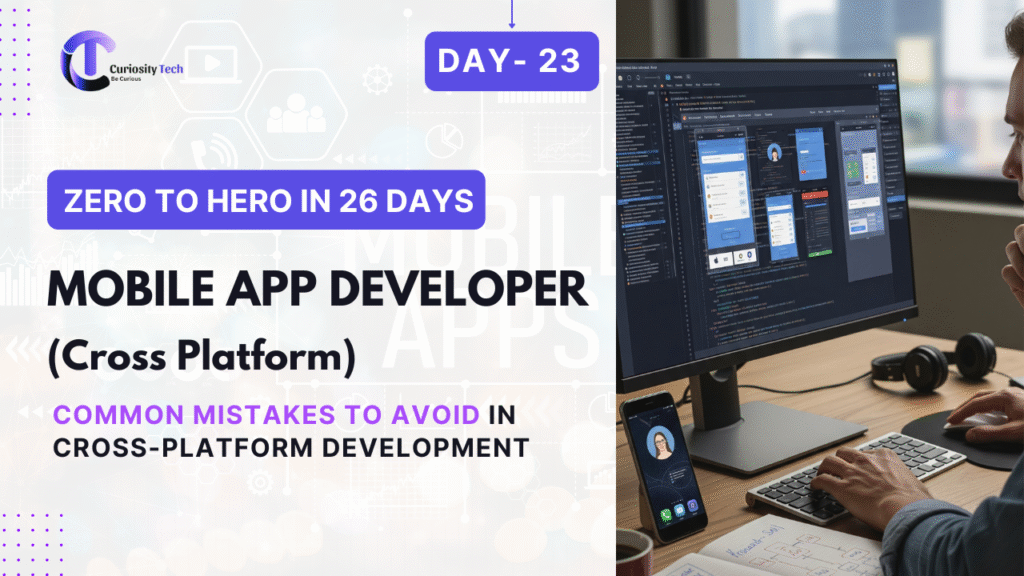Introduction
Cross-platform mobile development with Flutter and React Native allows developers to build apps for Android and iOS using a single codebase. While this approach accelerates development, it also introduces pitfalls that can affect performance, scalability, and maintainability.
This blog explores the most common mistakes developers make, with explanations, examples, and actionable guidance to help you avoid them, whether you are a beginner or an experienced professional.
1. Ignoring Platform-Specific Behavior
Issue
Developers often assume the app behaves identically on both iOS and Android. Differences in navigation, UI components, or gestures can lead to inconsistent experiences.
Example:
- Scroll behaviors differ between Android (ClampingScrollPhysics) and iOS (BouncingScrollPhysics).
- Safe area handling is crucial on iOS to avoid UI clipping near notches.
Solution
- Test apps on multiple devices and OS versions.
- Use platform checks and conditional rendering when necessary.
Platform.isIOS ? CupertinoButton(…) : ElevatedButton(…)
2. Overusing Third-Party Libraries
Issue
Relying heavily on external libraries can increase app size, introduce vulnerabilities, and cause conflicts.
Solution
- Evaluate libraries carefully for maintainability, popularity, and performance.
- Prefer native or framework-provided solutions whenever possible.
3. Poor State Management
Issue
Improper state management leads to unnecessary widget re-renders, performance degradation, and bugs.
Examples:
- Using setState globally in Flutter.
- Overusing useState or context in React Native for large components.
Solution
- Adopt scalable state management solutions:
- Flutter: Provider, Riverpod, BLoC
- React Native: Redux, MobX, Context API
4. Neglecting Offline Storage & Caching
Issue
Assuming users always have internet connectivity can break apps when offline or on slow networks.
Solution
- Implement offline-first architecture.
- Use Hive, SharedPreferences in Flutter or AsyncStorage, Realm in React Native.
- Cache API responses and assets effectively.
5. Not Optimizing Performance
Issue
Ignoring performance considerations can result in:
- Janky animations
- Slow screen transitions
- Memory leaks
Solution
- Optimize widget trees, FlatLists, animations, and network calls.
- Profile using Flutter DevTools or React Native Performance Monitor.
6. Inconsistent UI & UX
Issue
Designing without following platform-specific guidelines leads to confusing interfaces.
- Example: Using Material Design strictly on iOS can feel unnatural.
- Ignoring touch targets or accessibility reduces usability.
Solution
- Follow Material Design for Android and Cupertino guidelines for iOS.
- Test for accessibility and responsive layouts.
7. Weak Security Practices
Issue
Neglecting security exposes sensitive data and APIs.
Common Mistakes:
- Storing tokens in plain storage
- Hardcoding API keys
- No encryption on network requests
Solution
- Use secure storage, HTTPS, JWT tokens, and code obfuscation.
- Follow OWASP Mobile Top 10 recommendations.
8. Inadequate Testing
Issue
Skipping unit, widget, or integration tests results in unstable apps and unexpected crashes.
Solution
- Implement comprehensive testing strategy:
- Flutter: unit, widget, integration
- React Native: Jest, React Testing Library, Detox
9. Large App Sizes
Issue
Ignoring app size optimization can lead to slow downloads and poor user adoption.
Solution
- Remove unused assets and dependencies.
- Enable ProGuard for Android, Bitcode for iOS.
- Use split APKs and asset compression.
10. Ignoring Analytics & Monitoring
Issue
Without analytics, developers cannot identify performance bottlenecks or user issues.
Solution
- Integrate Firebase Analytics, Crashlytics, or Sentry.
- Monitor app behavior post-deployment for iterative improvements.
How to Become an Expert
- Develop cross-platform apps with robust architecture.
- Regularly test on different devices and OS versions.
- Learn from open-source projects and analyze common mistakes.
- Continuously optimize performance, security, and UX.
- Document lessons learned and refine coding standards.
Integrating CuriosityTech
At CuriosityTech (https://curiositytech.in), we help developers avoid common cross-platform mistakes by providing best practices in state management, offline storage, performance, security, and UI/UX consistency. Contact us at +91-9860555369, email contact@curiositytech.in, or visit 1st Floor, Plot No 81, Wardha Rd, Gajanan Nagar, Nagpur. Follow our insights on Instagram: curiositytechpark, LinkedIn: Curiosity Tech, and Facebook: Curiosity Tech.
Conclusion
Avoiding common mistakes is crucial for building reliable, performant, and secure cross-platform apps. By addressing platform-specific issues, optimizing performance, securing data, and maintaining consistent UX, developers can create professional-grade apps that delight users.



